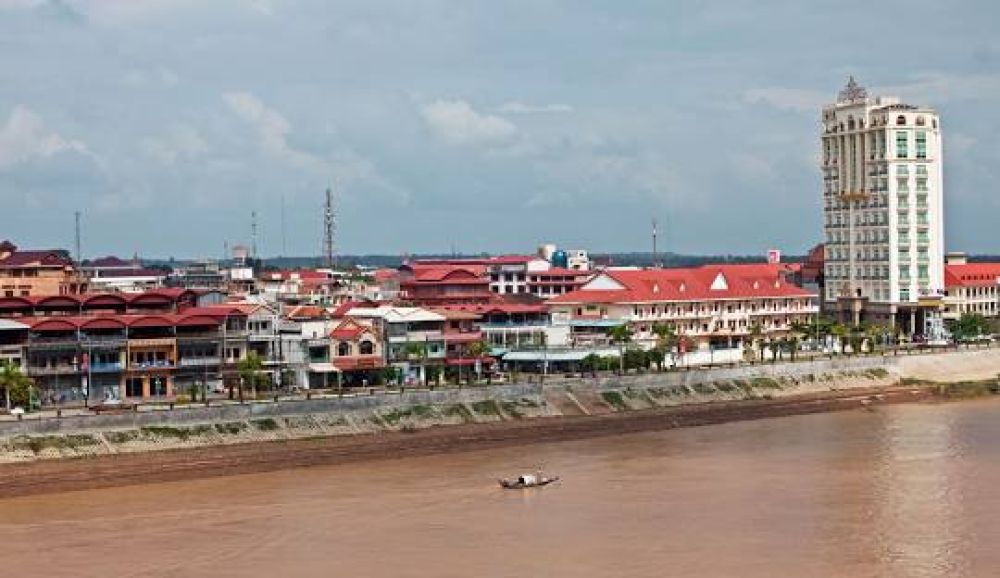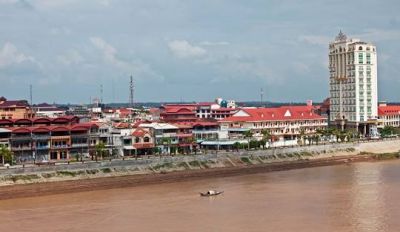

Wat Nokor Bachey is a fascinating cultural landmark located in Kampong Cham. This ancient temple complex dates back to the 11th century and showcases a beautiful mix of history and spirituality. Visitors to Wat Norkor can explore the aged, weathered structures that exhibit classic Khmer architecture with some elements displaying a fusion of Buddhist and Hindu influences. Within the main temple, you can observe a large bronze seated Buddha and many intricate carvings and bas-reliefs narrating mythological tales. Whether you're an ardent historian, an architecture enthusiast, or a spirituality seeker, you'll find the aura of Wat Nokor to be intriguing. As you stroll through the temple corridors and the surrounding pagodas, you may also encounter monks and take part in a tranquil meditation session or simply enjoy the peaceful atmosphere. Don't forget to bring your camera to capture the serene beauty and timeless appeal of this sacred place.
The Mekong River is the lifeblood of Kampong Cham, and the riverfront is the perfect place for a leisurely stroll, especially during the cooler hours of the early morning or late afternoon. As you walk along the promenade, you can take in views of the bustling river activity, with fishermen in their boats and locals enjoying the riverside ambiance. The scenery here is a beautiful blend of natural beauty and local culture, providing visitors with a glimpse into the daily life of Kampong Cham's residents. The riverfront area is lined with various food stalls and small cafes, enabling you to try local snacks or sip on a refreshing cool drink while you admire the surroundings. The walk is also an excellent opportunity for photography enthusiasts to capture the gentle rhythms of riverside life and the stunning sunsets that paint the sky in hues of orange and pink.
Exploring Koh Paen Island by bicycle is a lovely way to experience the rural landscapes and traditional lifestyle of the communities along the banks of the Mekong River. There are several places in Kampong Cham where you can rent a bike for the day and make your way to the island via the iconic bamboo bridge (seasonal) or by ferry. Once on the island, the cycling route will take you past verdant rice fields, traditional wooden homes on stilts, and beautiful temples. Along the way, you'll likely encounter friendly locals and get a firsthand look at their daily activities, such as rice farming and fishing. The gentle terrain and relatively short distance make this activity suitable for cyclists of all levels. Remember to bring water and sunscreen, as the Cambodian sun can be quite intense, especially during midday.
Cheung Kok Eco Village is a sustainable tourism project that aims to preserve traditional Cambodian crafts and provide visitors with an authentic glimpse into the everyday life of rural Cambodia. As part of this immersive experience, guests can participate in a guided tour of the village, which typically includes visits to local homes, handicraft workshops, and community gardens. The villagers are known for their warmth and hospitality, and they may invite you to try your hand at weaving or rice planting, depending on the season. You'll learn about sustainable practices and how the community works together to maintain its traditions while adapting to modern times. The tour ends with a traditional Khmer meal prepared by the villagers, providing a delicious conclusion to a day of cultural exploration.
Phnom Pros and Phnom Srei are two hills located just a short drive from the town center of Kampong Cham. These twin hills offer not only scenic views but also host a number of temples and statues with intriguing cultural significance. Phnom Pros (Man Hill) is crowned with a colorful pagoda and offers a leisurely hiking experience with well-paved paths and steps leading to the top. On the other hand, Phnom Srei (Woman Hill) is steeped in local folklore and offers a more challenging trek. Both hills are dotted with macaque monkeys that are accustomed to human visitors, which adds an element of excitement to the hike. Take your time exploring the pagodas and soaking in the panoramic views of the surrounding countryside. Be sure to dress respectfully and bring bottled water to stay hydrated during your adventure.
Located on the banks of the Mekong River and surrounded by lush bamboo forests, Hanchey Bamboo Resort is a tranquil escape offering a mix of relaxation and adventure. The resort provides opportunities to engage in yoga sessions, meditation, and wellness retreats. Visitors can also take part in activities like kayaking or cycling around the scenic area to enjoy the untouched natural surroundings. In addition to its recreational facilities, Hanchey Bamboo Resort serves as a cultural hub, organizing workshops where you can learn about traditional Cambodian arts, cooking, and bamboo crafts. Spending time here will not only soothe your soul but also give you a deeper understanding of sustainable tourism practices and the local ecosystem. Guests are welcome to dine at the resort's restaurant, which features farm-to-table cuisine that highlights fresh, local ingredients.
For food enthusiasts, a traditional Khmer cooking class is an excellent way to immerse yourself in Cambodian culture and cuisine. These classes often begin with a visit to a local market where you'll learn about the ingredients that are essential to Cambodian cooking, such as lemongrass, galangal, and kaffir lime leaves. Back in the kitchen, a skilled instructor will guide you through the process of preparing classic dishes like Fish Amok, Green Mango Salad, or Beef Lok Lak. As you chop, grind, and stir, you'll gain insights into the techniques and flavors that make Khmer cuisine so unique. At the end of the class, you'll have the chance to sit down and enjoy the delicious meal you've prepared. Not only will you leave with a satisfied palate, but also with new cooking skills and recipes to recreate at home.
Kampong Cham was once famous for its vast rubber plantations, which remain a significant part of the province's history and economy. Today, visitors can take guided tours to see the expansive fields and learn about the rubber tapping process. You'll discover the journey of rubber from tree to final product and the daily lives of those who work on these plantations. The tour typically includes demonstrations of rubber tapping and processing, where you'll observe skilled workers skillfully extracting the milky sap, which is then collected and processed into latex. These tours provide a unique industrial perspective on Cambodia's agricultural landscape, and they can be both educational and fascinating for visitors interested in understanding the country's plantation history and current practices.
The Kampong Cham Cultural Show is a vibrant showcase of traditional Cambodian arts, including classical dance, folk music, and shadow puppetry. Held at various venues around the city, these performances provide an enchanting evening of entertainment and cultural insight. Audiences can expect to see elaborately dressed dancers performing the Apsara Dance, which is a significant part of Khmer cultural heritage. Musicians playing traditional instruments such as the roneat (a bamboo xylophone) and the chapei dang veng (a long-necked lute) provide the mesmerizing soundtrack for the night. Shadow puppetry, another classical art form, tells tales of Cambodian folklore and mythology through intricately carved leather puppets. Attending one of these shows is a wonderful way to experience the rich artistic traditions of Cambodia and to support the local performers preserving these ancient art forms.
The seasonal bamboo bridge in Kampong Cham is a marvel of traditional engineering and a testament to the resourcefulness of the local community. Spanning the Mekong River to connect the city with Koh Pen (Koh Paen) Island, this bridge is constructed entirely from bamboo and is rebuilt every year after the rainy season. Crossing the bridge is an adventure in itself, as you can feel the bamboo beneath your feet while taking in the panoramic riverside views. The bridge is strong enough to support motorbikes and light vehicles, but walking across it gives you the full experience and the opportunity to take the best photos. Despite its fragile appearance, the bridge is an important lifeline for the island's residents, who use it to bring their products to the mainland's markets. It's one of the most unique activities in Kampong Cham and not to be missed if you visit during the dry season when the bridge is in place.
